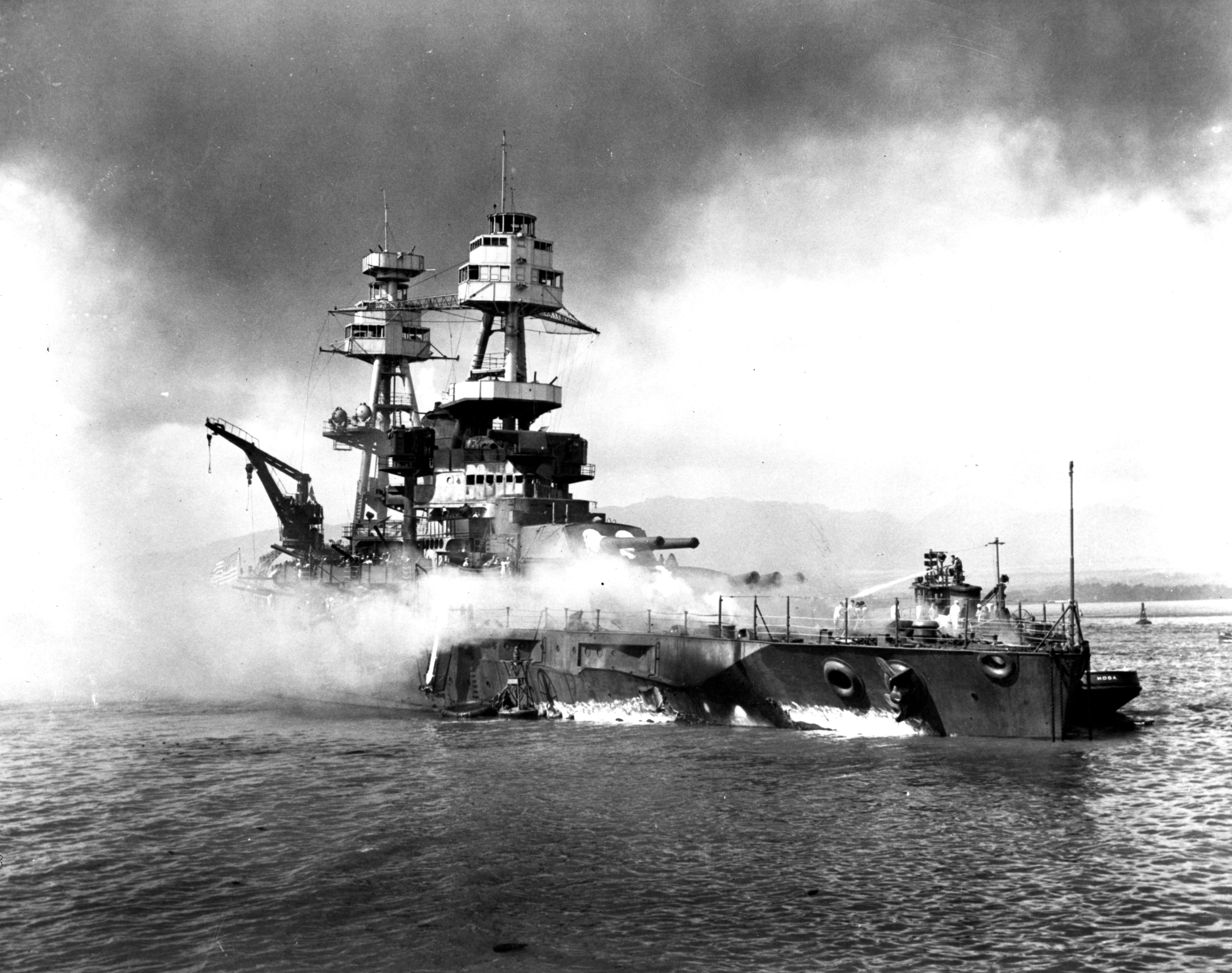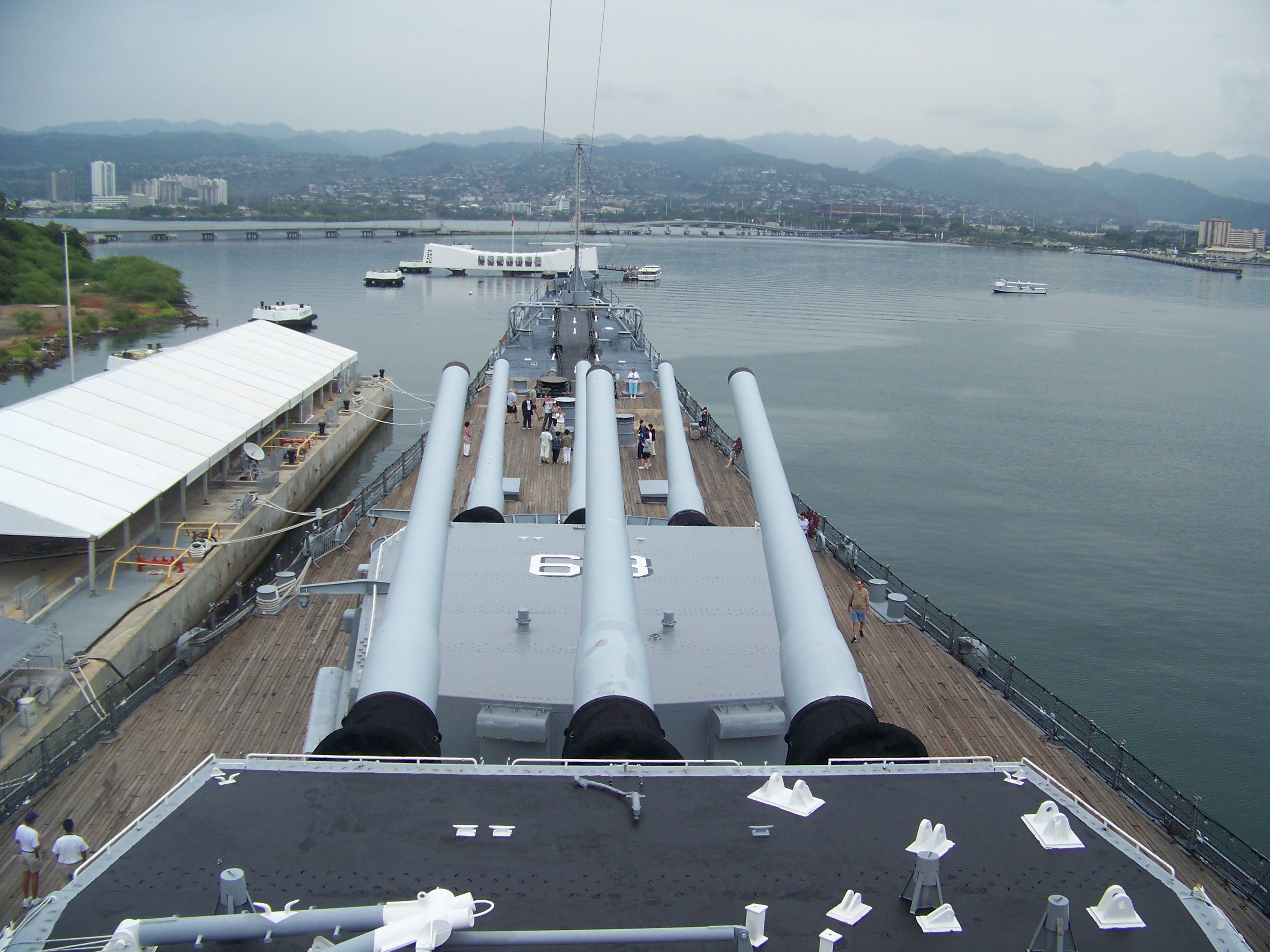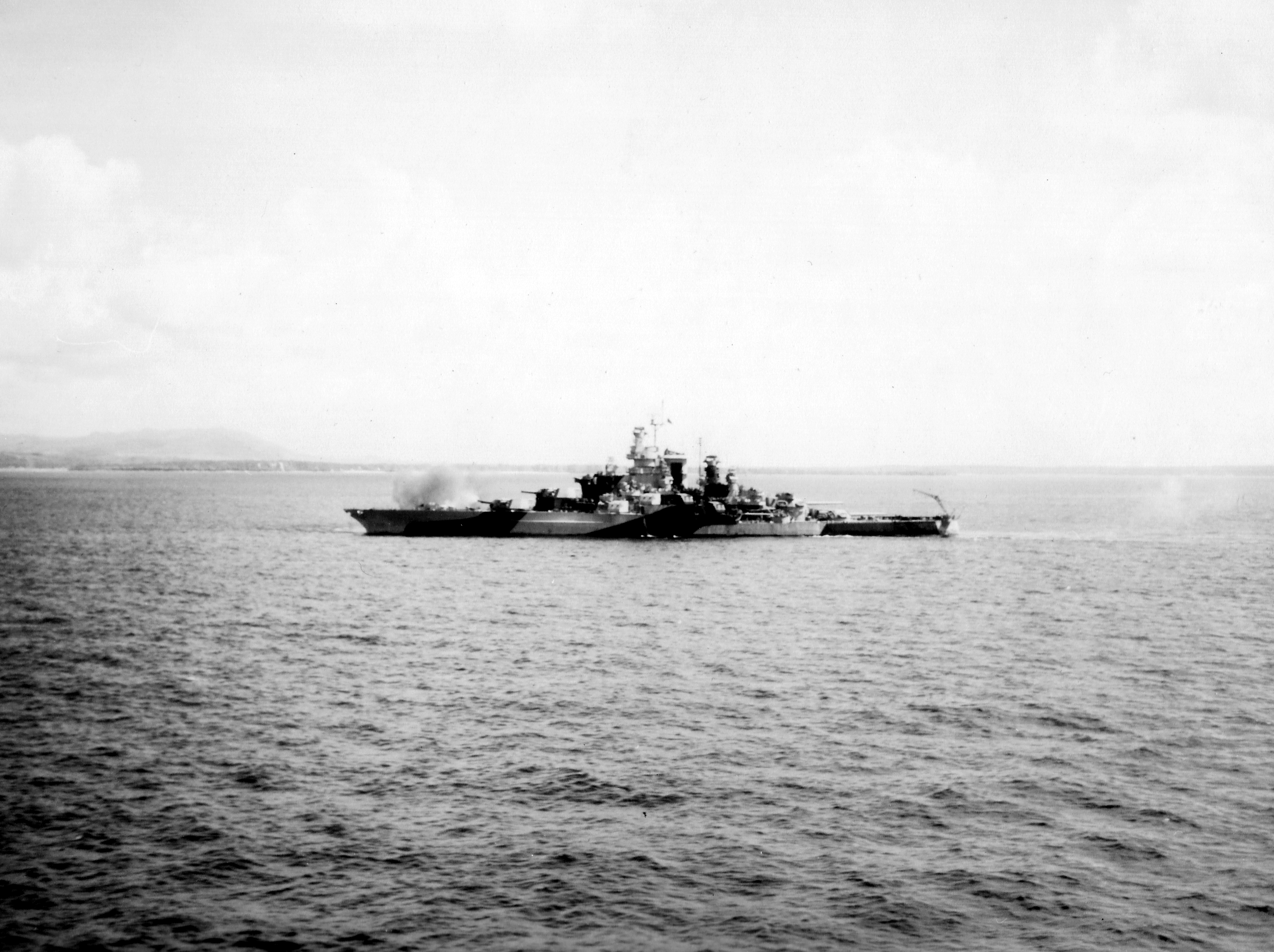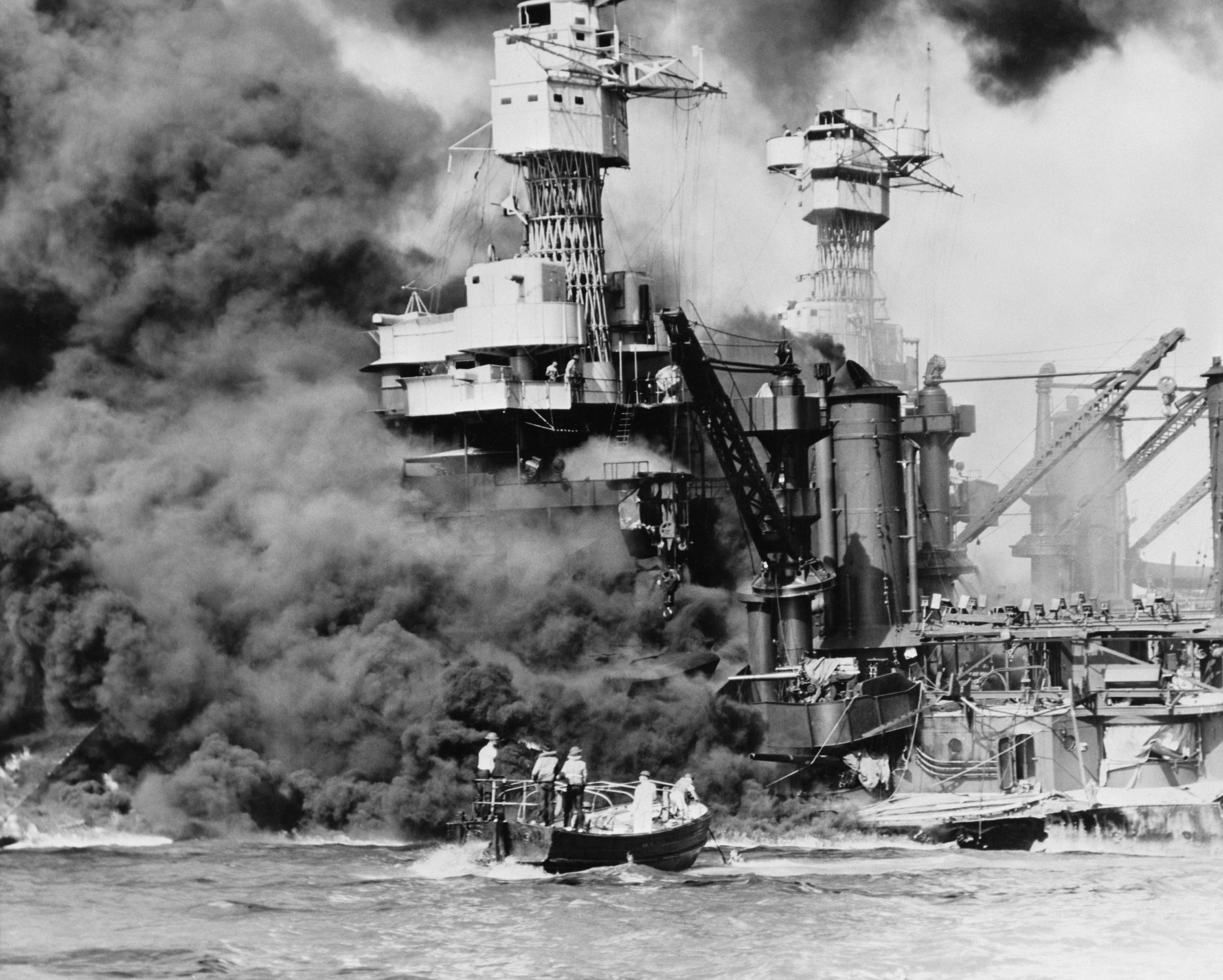- 1,999 United States Navy
- 233 United States Army (including the Air Corps)
- 109 United States Marine Corps
- 49 Civilians
2,390 in total. An additional 1,178 were wounded, and survived.
The Japanese attack on Pearl Harbor was devastating to the United States Navy's Pacific fleet. Naval doctrine prior to World War II focused on the centrality of the battleship. Naval war would be decided by big guns on both sides slugging it out shell for shell.
Pearl Harbor was the beginning of the end of the battleship as the dominant capital warship for the United States, mainly because with eight of the nine Pacific Fleet battleships destroyed or severely damaged, the aircraft carriers were the only striking force the US Navy had left.
The attack itself, clearly, was evidence of the ascendancy of the aircraft carrier. Two Japanese fast battleships - Hiei and Kirishima - accompanied Vice Admiral Chūichi Nagumo's 1st Air Fleet as escorts for the Pearl Harbor attack, but weren't involved in any shooting. Aircraft from the six Japanese carriers - Akagi, Hiryū, Kaga, Shōkaku, Sōryū, and Zuikaku - did all the damage.
What was the ultimate cost to the United States Navy in capital ships? Here's what happened to all nine battleships, listed in order of their hull numbers, belonging to the Pacific Fleet on December 7, 1941.
I hope you take the time to read the whole thing.
USS Nevada (BB-36)
Commissioned in 1916, Nevada was the lead ship of a new class of battleships - the first built for the United States Navy to use fuel oil from construction rather than coal-fired boilers. She was modified during a 2 1/2-year refit in 1927-1930.
On December 7th, Nevada was the only of the battleships in Pearl Harbor that wasn't sharing its moorings with another vessel. Her engineers got up steam, and she tried to escape the harbor. Contemporaneous accounts from the attack say that being able to see Nevada making for open ocean as bombs and torpedoes were exploding was a gigantic morale boost. At around 0950 local, she was struck by five bombs; too much damage for her to continue. Nevada beached at Hospital Point at about 1030 hours so as not to block the harbor. 60 men were killed and 109 wounded aboard her.
 |
| USS Nevada beached after the Pearl Harbor attack |
The Japanese thought her sunk and destroyed, but Nevada wasn't done by a long shot. Refloated by the Navy on February 12, 1942, emergency repairs were made - just enough for Nevada to sail for the Puget Sound Navy Yard in Washington state. She received a major overhaul and modernization. Emerging from overhaul in October 1942, Nevada got her first taste of revenge with the operation to recapture the Alaskan island of Attu in May 1943. She then left the Pacific for service with the Atlantic fleet.
USS Nevada, sunk at Pearl Harbor, unleashed her ten 14-inch guns against Nazi German positions in Normandy on D-Day, June 6, 1944. For four months she provided fire support to our forces ashore.
_fire_on_positions_ashore.jpg) |
| Forward 14" guns of Nevada bombarding France on D-Day |
Nevada used those three guns from Arizona as part of the bombardment fleet for the invasions of both Iwo Jima and Okinawa. Were it not for the atomic bomb, those guns assuredly would have shelled Japan as well.
She finished her wartime service as part of the occupation force in Tokyo Bay, a fitting place for a ship who ended the first battle of World War II on the bottom of Pearl Harbor. Now over 32 years old, Nevada was decommissioned and used as a target.
Oklahoma was Nevada's sister-ship, built to the same design and specifications, and also commissioned in 1916. Like her sister, she had been modernized and updated through refits during 1927-1929.
On December 7th, she was moored outboard of the USS Maryland (below). Three Japanese air-dropped torpedoes struck her, causing her to flood and capsize. As she began to roll, she was struck by two more torpedoes, sealing her fate. Just twelve minutes after the first bombs fell, Oklahoma was sunk.
 |
| Capsized USS Oklahoma with damaged USS Maryland behind |
Oklahoma suffered the loss of 429 of her crew. The survivors, even as their ship was being destroyed under them, continued fighting. Many of them climbed aboard the Maryland to man anti-aircraft batteries and assist with firefighting and damage control.
The Navy began salvage operations on Oklahoma in July 1942. She wasn't righted until June 1943. After drydocking, the Navy determined that the ship was too damaged to be properly repaired. Oklahoma was decomissioned on September 1, 1944 and stripped of her armaments and superstructure.
Destined for a shipbreaker, the hull of Oklahoma sank under tow back to the US mainland during a storm on May 17, 1947.
Pennsylvania was the lead ship of another battleship class. When commissioned in 1916, she became the flagship for the Commander in Chief, Atlantic Fleet. Like other World War I battleships, she was modernized in the 1920s and 1930s.
When the Japanese attacked Pearl Harbor, Pennsylvania was dry docked. She received damage from bomb strikes and from shrapnel produced by bomb strikes on two other ships in the dry dock, destroyers Cassin and Downes. Coming through the attack relatively unscathed with 15 crew KIA, 14 MIA, and 38 wounded, she set sail for the mainland and full repairs just 13 days after the attack.
Pennsylvania served with distinction throughout the war in the Pacific. Like Nevada, she met her end post-war as a target.
Arizona was the second and final Pennsylvania-class battleship, also commissioned in 1916. As with the other World War I-era battleships, she had received refits and modernization during the 1920s and 1930s. Her last yard period before the attack ended in January 1941.
 |
| USS Arizona (BB-39) as she appeared in the 1930s |
Three days prior to the attack, Arizona participated in night gunnery exercises along with Nevada and Oklahoma. Upon returning to Pearl Harbor, the repair ship USS Vestal moored along side Arizona on Battleship Row to assist with maintenance.
Arizona's crew was alerted to the attack by the general quarters alarm at 0755. At approximately 0800, 10 Japanese bombers singled out Arizona and Vestal for attack. Arizona was struck by four bombs, Vestal two, and there were also three near misses.
At 0806, a fifth armor-piercing bomb struck Arizona. The bomb impacted on her foredeck in the vicinity of Turret II, penetrated the protective armor, and likely detonated inside the forward main battery magazines.
 |
| USS Arizona is destroyed by forward main battery magazine explosion |
Seven seconds after the bomb hit, the powder and ammunition inside the forward main battery magazines exploded, venting mainly through the sides of the ship, collapsing the entire forward structure, and setting off tertiary fires and explosions throughout the vessel. The massive explosion that destroyed Arizona actually blew out the fires on board Vestal from the blast pressure.
She quickly sank to the bottom of the harbor, with 1,177 of her crew. Arizona's fires burned for two days.
 |
| Arizona in the aftermath |
Arizona was finally decommissioned and struck from the Naval Vessel Register on December 1, 1942. Salvage operations began by scrapping the superstructure. Both of her aft triple-14" gun turrets were removed and used as coastal artillery batteries to defend Hawaii. Turret II was also salvaged, and those guns went to war aboard Nevada in 1945 (above).
In 1962, the USS Arizona Memorial was dedicated. I have been there. I will never forget what I saw. Arizona lies today in view, with some structure visible varying with the tides. Her fuel tanks, still containing naval fuel oil, slowly seep into the harbor to this day.
 |
| Arizona as she lies today |
I believe that visiting the Arizona as she lies is a pilgrimage that every American must make if they are able to do so. It is an incredibly moving experience. I visited her and paid my respects to the lost a few days after Election Day in November, 2000. You will cry, and you should. You will stand for minutes, as I did, and look at the wall of honor where all of Arizona's dead are listed. You are standing above the collective grave for most of them.
 |
| "To the memory of the gallant men here entombed and their shipmates who gave their lives in action on December 7, 1941 on the USS Arizona" |
Today in Pearl Harbor, the battleship USS Missouri (BB-63) is permanently moored forward of Arizona's resting place. Missouri can be toured, and you can stand upon the spot where Imperial Japan signed the instruments of surrender on her foredeck on September 2, 1945.
 |
| View of Arizona from Missouri |
Missouri sits with her bow pointed towards Arizona; the six 16-inch guns of her forward main battery forever watching over her sunken predecessor. This is the only place on earth where both the beginning and the end of World War II are together. Victory, as it always should, rises above defeat.
Commissioned in 1920, Tennessee was the first of a new two battleship class, the other being the USS California, chronicled next.
On the morning of December 7, 1941 Tennessee was moored with West Virginia (below). During the Japanese attack, she came through much better than the other battleships, suffering only two bomb hits - neither bomb penetrated a vital area or exploded high-order. West Virginia, however, sunk and Tennessee was trapped between her sunken comrade and the mooring quays for 10 days following.
After being freed from the mooring and receiving band-aid repairs, Tennessee set sail for the Puget Sound Navy Yard, complete repairs, and some modifications.
She emerged from the yard in early 1942 and immediately joined the US Navy forces protecting the west coast from a potential, and at the time widely feared, Japanese strike against the mainland. In 1943, she found herself back in the shipyard for an extensive modernization.
From 1943-1945, Tennessee participated in every major offensive campaign of the War in the Pacific: Aleutians, Tarawa, Marshall Islands, Bismark Archipelago, Mariana Islands, Palau, Leyte Gulf, Surigao Strait, Iwo Jima, and Okinawa. She steamed a total of 170,073 miles, and flung 9,347 14" shells from her main battery along with 46,341 shells from the secondary 5" batteries at our Japanese enemies.
 |
| USS Tennessee bombards Japanese positions on Guam, July 1944 |
Decommissioned to reserve status on February 14, 1947, USS Tennessee was struck from the Naval Vessel Register on March 1, 1959 and sold for scrap later that same year.
Tennessee's sister ship California joined the fleet in 1921. For many of the years up to 1940, she served as the flagship of the Pacific Fleet.
On December 7, 1941 she was moored at the southern end of Pearl Harbor's Battleship Row. Prior to the attack, her crew was preparing for material and equipment inspections and her watertight integrity was compromised. Two torpedo hits in rapid succession caused California to begin taking on water. Near-miss bomb blasts buckled her hull plates, causing even more flooding. She sank to the bottom of the harbor, decks awash, with the loss of 100 of her crew.
Salvage operations on California did not begin until early 1942. She was refloated on March 25th, and left Hawaii under her own power on June 7, destined for the Puget Sound Navy Yard. California, more heavily damaged than her sister Tennessee, did not rejoin the fleet until 1944. She continued to serve in the Pacific, primarily in the role of gunnery support for amphibious landings.
Like Tennessee, California was decommissioned to reserve on February 14, 1947 and sold for scrap in July of 1959.
Colorado was the lead ship of a new, four-battleship class and joined the fleet in 1923. The Colorado-class' major innovation in fighting ships was the switch from 14" to 16" main guns. In her pre-war actvities, Colorado participated in the search for lost aviator Amelia Earhart in 1937.
December 7, 1941 left Colorado as the only undamaged battleship in the Pacific. She wasn't at Pearl Harbor, having entered the Puget Sound Navy Yard on June 25, 1941. Her modifications done on March 31, 1942 she joined the forces protecting the west coast.
One particular incident involving Colorado deserves special recognition. Beginning on July 24, 1944 Colorado was providing naval gunfire to the forces fighting on the island of Tinian. She received 22 hits fired from Japanese shore batteries and kept fighting until August 3 despite the damage.
 |
| USS Colorado after the Tinian Battle, multiple shell holes visible |
While supporting the recapture of the Philippines in November 1944, Colorado was struck by two kamikaze planes and survived.
She was decommissioned to reserve status in 1947, and scrapped in 1959.
Maryland, of the Colorado-class but the first to enter service in 1921, had made a goodwill trip to Australia and New Zealand with the Pacific Fleet in 1925. In 1928, she transported President Herbert Hoover for the Pacific leg of his Latin America tour.
On December 7th, Maryland was moored inboard of Oklahoma. She received two bomb hits, but most of the ordnance expended in her area found the doomed Oklahoma instead. By mid-morning, the situation aboard had improved, and Maryland sent damage control teams to assist with firefighting on other stricken ships.
 |
| USS Maryland on left, capsized USS Oklahoma on right |
The Japanese had counted Maryland as sunk, but by December 30, 1941 she was sailing into Puget Sound for refit and modifications. Emerging from the yard in late February 1942, she participated in the decisive Battle of Midway in June.
Like the other Pacific battleships, Maryland was too slow to keep up with aircraft carrier-based task forces and spent the rest of the war as gunfire support for amphibious assaults. And, like most of the others, she decommissioned to reserve status in 1947 and was scrapped in 1959.
West Virginia, also of the Colorado-class, joined the fleet in 1923.
When the Japanese attacked Pearl Harbor, she was moored to the outboard of Tennessee with 40 feet of water under her keel. The bulk of damage done to West Virginia was from air-dropped torpedoes, but there is also some evidence that she was also struck by one or more torpedoes fired from a Japanese midget submarine that infiltrated the harbor.
One torpedo destroyed the ship's rudder and steering gear. Three more impacted below the armor belt, causing severe flooding. Other torpedoes struck the armor, buckling it. It's also thought that one or more torpedoes may have entered the ship through previous blast holes, detonating well inside the vessel.
Quick action by West Virginia's damage control crews allowed the ship to flood, and thus settle, evenly. West Virginia burned and sank, but she did not capsize like the less fortunate Oklahoma.
Severe damage was also caused by two bomb hits and by the massive fires from Arizona that at times engulfed West Virginia. She settled on an even keel, and was abandoned.
West Virginia lay flooded with her decks awash until the spring of 1942 when salvage operations began. She was refloated on May 17th, and moved to one of the dry docks at Pearl. Repair crews recovered 66 more of their slain comrades, and made some tragic discoveries. Several of the men killed survived the torpedo strikes and flooding, only to be trapped to die of suffocation. Three men were found together in a compartment; a calendar they had indicated that they lived, waiting for a rescue that wouldn't come, for 16 days.
West Virginia finally left Pearl Harbor for final repairs and refit on May 7, 1943. Because she was the most heavilly damaged vessel from Pearl Harbor to survive, she was also the last to rejoin the fleet. Rejoining the war in the Pacific in late 1944, she served with distinction for the rest of the war including the recapture of the Philippines and the attacks on Iwo Jima and Okinawa. Decommissioned 1947, scrapped 1959.
_1944_7.jpg) |
| Rebuilt USS West Virginia, 1944 |
Conclusions
Nine ships, eight of which were at Pearl Harbor. Of the eight, two were sunk and deemed destroyed/unsalvageable: Arizona and Oklahoma. Of the other six, four returned to service in 1942 and two in 1944.
These older battleships were limited to top speeds of around 21 knots; too slow to serve with aircraft carriers that could make 30+ knots. They likely would have diminished in importance even if the damage to the battle fleet had been less. All seven surviving Pacific fleet battleships after December 7, 1941 got their revenge in combat. All seven survived the war.
The Pearl Harbor attack was a national shock. Thousands lost their lives. The impact of Japan's attack was just strategic and psychological though. The Japanese did great damage for certain, but they did not ultimately accomplish their mission. Three-fourths of the battleships damaged or sunk on December 7, 1941 - all assumed by the Japanese to be destroyed - returned to the war. Based upon their battle records after Pearl Harbor, it's pretty clear that were it not for the Pearl Harbor survivors Nevada, Pennsylvania, Tennessee, California, Maryland, and West Virginia - plus the undamaged Colorado - the story of World War II could have been very different had those seven not survived to fight another day.
And fight well, they all did.



No comments:
Post a Comment
COMMENTS ARE CLOSED. NO ADDITIONAL COMMENTS WILL BE POSTED HERE. IF YOU WISH TO COMMENT, PLEASE GO TO THE NEW BLOG SITE – http://theirfinesthour.net – AND LEAVE YOUR FEEDBACK THERE!!!
Note: Only a member of this blog may post a comment.